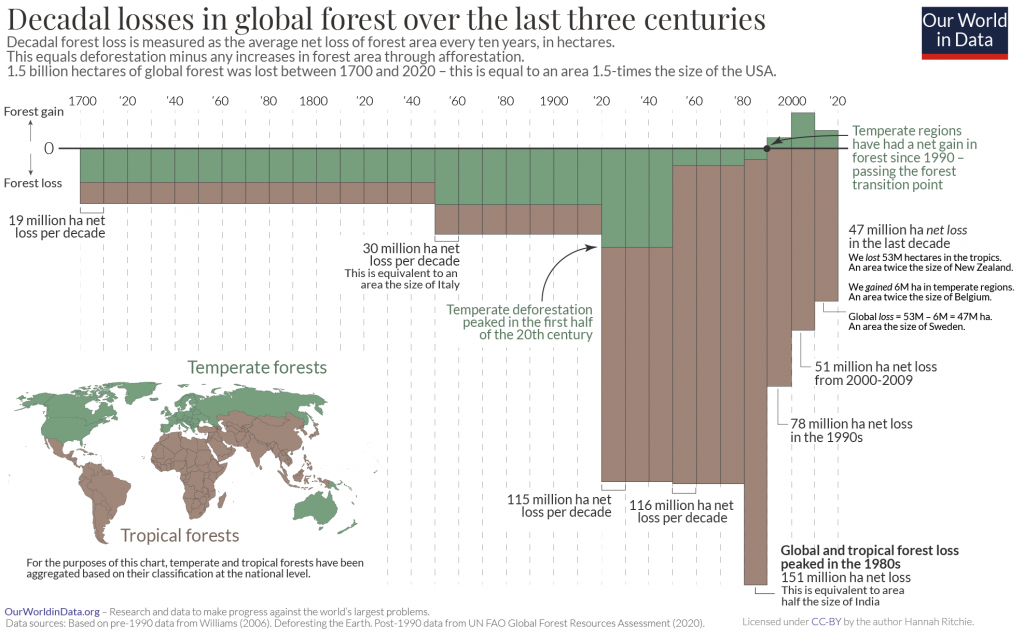How Sustainable Is Cypress Wood? Here Are the Facts
Impactful Ninja is reader-supported. When you buy through links on our site, we may earn an affiliate commission.
Learn more
Learn more
.
Hey fellow impactful ninja ? You may have noticed that Impactful Ninja is all about providing helpful information to make a positive impact on the world and society. And that we love to link back to where we found all the information for each of our posts. Most of these links are informational-based for you to check out their primary sources with one click. But some of these links are so-called "affiliate links" to products that we recommend. First and foremost, because we believe that they add value to you. For example, when we wrote a post about the environmental impact of long showers, we came across an EPA recommendation to use WaterSense showerheads. So we linked to where you can find them. Or, for many of our posts, we also link to our favorite books on that topic so that you can get a much more holistic overview than one single blog post could provide. And when there is an affiliate program for these products, we sign up for it. For example, as Amazon Associates, we earn from qualifying purchases. First, and most importantly, we still only recommend products that we believe add value for you. When you buy something through one of our affiliate links, we may earn a small commission - but at no additional costs to you. And when you buy something through a link that is not an affiliate link, we won’t receive any commission but we’ll still be happy to have helped you. When we find products that we believe add value to you and the seller has an affiliate program, we sign up for it. When you buy something through one of our affiliate links, we may earn a small commission (at no extra costs to you). And at this point in time, all money is reinvested in sharing the most helpful content with you. This includes all operating costs for running this site and the content creation itself. You may have noticed by the way Impactful Ninja is operated that money is not the driving factor behind it. It is a passion project of mine and I love to share helpful information with you to make a positive impact on the world and society. However, it's a project in that I invest a lot of time and also quite some money. Eventually, my dream is to one day turn this passion project into my full-time job and provide even more helpful information. But that's still a long time to go. Stay impactful,Affiliate Disclosure
Why do we add these product links?
What do these affiliate links mean for you?
What do these affiliate links mean for us?
What does this mean for me personally?
![]()
Cypress wood makes long-lasting musical instruments, flooring, and garden decking, thanks to its natural durability. However, the populations of important cypress timber species are decreasing due to regeneration difficulties within their natural range. So we had to ask: How sustainable is it to buy products made out of cypress wood?
Cypress wood is sustainable thanks to the trees’ carbon sequestration. The high rot resistance and excellent stability make cypress a durable option for interior and exterior projects. Also, emissions from transporting cypress timber are relatively low as it is a lightweight, domestic wood.
In this article, we’ll walk you through the life-cycle of cypress wood used in furniture, musical instruments, and exterior projects. Then, we evaluate its sustainability, potentials, and shortfalls. And in the end, we’ll show you tips for buying sustainable cypress wood.
Here’s How Sustainable Cypress Wood Is
Cypress wood is a sustainable material because of the trees’ carbon sequestration and the carbon offset value at the end of any products made with cypress wood.
“Sustainable: The ability to be maintained at a certain rate or level | Avoidance of the depletion of natural resources in order to maintain an ecological balance”
Oxford Dictionary
To better understand the sustainability of cypress wood, we assess the life-cycle of projects like decking or musical instruments. This life-cycle assessment (LCA) is a method to evaluate the environmental impacts of each stage in a product’s life-cycle, from the making to the recycling. Over the years, companies have strategically used LCA to research and create more sustainable products.
In this article, we’ll use the cradle-to-grave perspective of the LCA, examining the five stages of the life cycle of cypress wood. Where it is relevant, we also use data from cradle-to-gate assessments.
| The life-cycle stages of cypress wood | Each stage’s sustainability |
| Growing of cypress wood | Growing cypress trees for timber is sustainable thanks to the carbon sequestration potential. |
| Manufacturing of cypress wood | Turning cypress wood into furniture has a relatively low carbon footprint because wood waste can be recycled fully as by-products or biomass pellets to offset the carbon emissions during harvesting and processing. |
| Transporting of cypress wood | Transporting is a relatively carbon-intensive stage in the life cycle of cypress wood furniture due to the emissions associated with operating the hauling vehicles that take timber to sawmills and factories, then furniture to stores. As cypress wood is a local, lightweight timber, the carbon emissions of transporting cypress products would be relatively low, especially to locations along the US west coast. |
| Usage of cypress wood | Using cypress furniture, decking, and musical instruments can be sustainable thanks to the carbon capture during the products’ long life. |
| End-of-life of cypress wood | The end-of-life stage for cypress furniture, decking, and musical instruments is sustainable when the wood is reused or burned as bioenergy. |
Overall, we can say that cypress wood is fairly sustainable. However, the actual environmental impact of a particular product, like the back of a guitar or a garden set, depends on many factors, especially the distance and mode of transportation. Let’s dive deeper into each stage and find out how it can be more sustainable.
How Sustainable Is the Growing Cypress Wood
Growing cypress trees for timber is sustainable thanks to its carbon sequestration potential.
What Type of Wood Is Cypress Wood and What Does This Mean for Sustainability
Cypress trees belong to the family Cupressaceae (the cypress family). This coniferous family has about 30 genera and 130 species. Many species in this family have gone through (repeatedly) reclassification. A prime example is the Nootka cypress.
Nootka cypress has always had the label “nootkatensis,” which comes from the Nuu-chah-nulth people of Canada.
- But the botanic name of this genus of the tree has been reclassified many times.
- It is perhaps one of the woods with the most often-changed and reclassified botanical name.
- Botanically, the Nootka cypress was first classified as a Chamaecyparis genus, then a Xanthocyparis genus.
- Xanthocyparis was a genus created to group two species: Nootka cypress and its closest cousin from the other side of the Pacific – the Vietnamese golden cypress.
- After that, it spent some time as a Callitropsis before finally becoming a Cupressus.
Currently, the Nootka cypress is classified as the Cupressus nootkatensis genus. However, it is still commonly referred to by many woodworkers and traders as Alaska yellow cedar. So the Nootka cypress is a (true) cypress that is sometimes (confusingly) called a cedar. (You can read our cedar article to learn more about different timber species falling into this timber group.)
Because of the number of species in the family and changes in classification, you might find timber labeled “cypress wood” coming from various tree species with distinctive characteristics and native ranges.
In this article, we cover the two most important Cupressus species (true cypress) that grow natively in the western states of the US. These are Nootka Cypress (Cupressus nootkatensis) and Monterey Cypress (Cupressus macrocarpa).
These species are light and reasonably hard for softwood species. Most importantly, these woods are highly durable in contact with the ground. Thus, they are especially valuable for outdoor applications like fence posts or decking.
There will also be spotlights on Leyland Cypress (Cupressus x leylandii) – a hybrid between the two cypress species mentioned above. Leyland Cypress was created in Wales, UK but is now planted over a large range of the US.
The growth rates of Nootka Cypress and Monterey Cypress vary from slow to medium, depending on the ages and the growing sites.
On the contrary, the sterile hybrid of these two parents is a fast grower. Leyland cypress’s average annual height increase is over 2 feet per year. Even on sites of relatively poor conditions, these trees have been known to grow to heights of 50 feet in the first 15 years.
There is another commercially important timber from the US forests with the cypress label in its name: the bald cypress. However, it is a Taxodium species and will not be covered in this article.
From this point on, when we use the word “cypress,” we refer to the three species: the naturally-occurring Nootka Cypress and Monterey Cypress; and the sterile hybrid Leyland cypress. When necessary, we will provide examples specific to each individual speci
How Sustainably Does Cypress Wood Grow
Cypress trees’ sustainability lies in their carbon sequestration potential.
As cypress trees grow, they absorb CO2 from the atmosphere while releasing oxygen. They act as a carbon sink during their long lifespan. Nootka cypress can live as long as 3,500 years.
As a carbon sink, cypress trees pull greenhouse gasses out of the atmosphere, helping to mitigate the climate crisis. Trees store as much carbon as 50% of their dry weights. Thus, a tree stores more carbon as it grows taller and bigger. Nootka cypress and Monterey cypress trees can reach 120 and 80 feet in height, respectively.
Where Is Cypress Wood Usually Grown
In this article, we cover the two most important Cupressus species (true cypress) that grow natively in the western states of the US. These are Monterey Cypress (Cupressus macrocarpa) and Nootka Cypress (Cupressus nootkatensis).
The natural range of Monterey Cypress
Monterey cypress is endemic to the central coast of California.
- This Cupressus macrocarpa species occurs naturally only in two stands across Monterey County, California.
- This restricted natural range and regeneration challenges put Monterey cypress on the IUCN Red List.
However, this tree species has been widely cultivated outside its natural range: along the California coast as well as in Hawaii, Europe, South America, Australia, and New Zealand.
Monterey cypress typically grows in pure stands with an understory of scattered small shrubs and perennial herbs. These trees are associated with closed-cone coniferous woodlands.
Monterey cypress is a fire-adapted species with serotinous cones.
Seroninous cones are closed cones that keep their seeds in the canopy rather than releasing them within the annual cycle in fall. Seeds can be held in the cones for two years or more. Seroninous cones do not open on their own.
- Instead, these closed cones require a trigger like the high heat from a fire before they open and drop the seeds.
- Serotiny is primarily caused by fire.
- However, there are other triggers, including periodic excess moisture, conditions of increased solar heat, atmospheric drying, and parent plant death.
Serotiny is less pronounced in Monterey cypress than in other California cypress species like MacNab, Baker, or Gowen. Monterey cypress can release seeds with or without crown fire. However, fire provides the optimum site conditions for regeneration in Monterey cypress.
The fire management practices in California have led to many stands of cypress species with serenity tendency to disappear. When the interval between human-induced fires is too short, trees are unable to reach reproductive age before the next fire happens.
Besides, the climate crisis has increased the extreme fire weather in terms of heat and frequency, worsening the reproduction challenges of Monterey cypress and Californian serotinous species.
The natural range of Nootka cypress
Nootka cypress (Cupressus nootkatensis) grows naturally from Alaska to northern California. This species is mostly found within 150 miles of the Pacific coast.
Though Nootka cypress occasionally grows in pure stands, this timber species is more often spotted as a stand-alone tree or in scattered groups mixed with other tree species. Consequently, harvesting this timber demands traveling to different locations, resulting in high fuel consumption.
Nootka cypress is a slow-growing conifer. In the northern part of its range, cones need an extra year (i.e., 2 years) to mature.
Cypress timber species are not easy to regenerate. Natural difficulties include:
- The long times for producing cones and for cones to reach maturity
- The necessity of extreme weather events to occur
- The inability to reproduce naturally (in the case of Leyland cypress)
Because of these reproduction challenges, harvesting cypress is not as sustainable as harvesting other fast-growing, abundant coniferous species like Douglas fir or western red cedar.
Besides, harvesting cypress in natural forests, especially old-growth forests, can result in loss of biodiversity regarding tree species and wild animals that feed and shelter in the woods.
Biodiversity loss regarding tree species
One example is when loggers only cut down the biggest and tallest trees. That pattern would cause a reduction in the genetic diversity and quality of the trees within the stand, leading to gradual degradation of tree quality.
Biodiversity loss regarding forest animals
Cutting down cypress trees also disrupts the forests’ wild animals, which depend on the forest for food and shelter.
Illegal logging in the US is unfortunately not non-existent. The only way for you as a consumer to tackle problems caused by illegal logging is to source sustainable woods. We will point you in the right direction with cypress wood at the end of this article.
In total, logging of forestry products from plantations accounts for 26% of forest loss, which is a combination of deforestation and forest degradation. However, the loss in bio-diverse forests in tropical climates is more significant (and sometimes less properly recorded) than in temperate, well-managed logging forests.

How Sustainable Is the Manufacturing of Cypress Wood
Turning cypress wood into furniture has a relatively low carbon footprint because wood waste can be recycled fully as by-products or biomass pellets to offset the carbon emissions during harvesting and processing.
The first step of manufacturing cypress furniture, decking, and musical instruments involves cutting down trees and turning them into lumber in a sawmill. Electricity is needed to run sawing machines.
The next step is to dry lumber before turning it into a household item. If a piece of lumber can be air-dried to the desired moisture content, no added energy is needed for this step. However, if a kiln is used, it requires extra energy, which could mean higher carbon emissions.
Cypress timber has a low tendency of checking and warping. Also, the wood is dimensionally stable, so drying is relatively straightforward. For example, it takes four and a half days to kiln dry 1-inch timber of Nooka cypress to a 7% moisture content.
A high proportion of energy (to power sawing machines and kilns) can come from renewable sources, including solar, wind, hydroelectric, geothermal, and biomass.
How Sustainable Is the Transportation of Cypress Wood
Transporting is a relatively carbon-intensive stage in the life cycle of cypress wood furniture due to the emissions associated with operating the hauling vehicles that take timber to sawmills and factories, then furniture to stores.
As cypress wood is a local, lightweight timber, the carbon emissions of transporting cypress products would be relatively low, especially to locations along the US west coast.
For example, the Nootka cypress is a popular wood for outdoor decking, thanks to its natural durability. Because of the timber’s low weight and natural range, its transporting footprint tends to be lower than other decking hardwood materials like white oak (local hardwood) or ipe (imported hardwood), teak (imported hardwood), or mahogany (imported hardwood).
The actual emission during this stage depends on the type of vehicles used, the fuel they need, and the distance the wood travels. Calculations made by the Norwegian Forest and Landscape Institute showed that smaller wood hauling trucks emitted more CO2 per transported cubic meters of timber: 1.25 times more than larger wood hauling trucks, 1.3 times more than sea vessels, and six times more than freight trains. Therefore, the sustainable transportation option would be rail or large trucks running on biofuel. You can check with your wood suppliers how their products are transported and opt for the best option.
How Sustainable Is the Usage of Cypress Wood
Using cypress furniture can be sustainable thanks to the carbon capture during the products’ long life.
Nootka cypress is highly durable, thanks to the heartwood’s chemical compounds that inhibit fungal growth. It has excellent decay resistance and is also resistant to most insect attacks. Regarding strength, it is among the strongest US softwoods (comparable to Douglas fir), making it an ideal material for heavy-traffic decking.
Monterey cypress wood is also durable. Products made with Monterey cypress have 10 to 15 lifespan if in contact with the ground, and over 15 years above ground.
When cypress wood is decayed, either naturally in the forest or because of damage caused by usage at home, the carbon stored in the wood is released back to the atmosphere. Therefore, long-lasting furniture can be considered a good way of keeping carbon out of the atmosphere. If the wood is then reclaimed for making another piece of furniture, its positive carbon storage environmental impact is even higher.
How Sustainable Is the End-of-Life of Cypress Wood
The end-of-life stage for cypress wood furniture, decking, and musical instruments is sustainable when the wood is reused or burned as bioenergy.
There are a few scenarios for wood products – outdoor furniture, musical instrument, and building material – at the end of their life:
- They can end up in landfills and don’t decompose. In this case, it keeps its role as carbon storage.
- Wood products can also be upcycled and reused, extending their role as carbon storage. New wood products often travel much further to their markets, compared with recovered wood products. The latter is typically made in urban centers and sold locally, which lowers the transportation environmental burdens.
- In another end-of-life scenario, products like a garden chair can be burned for biomass energy displacing coal or natural gas in generating electricity.
With smaller household items, such as the sides of a guitar, the offset won’t be as high as there is much less waste for burning. However, if such products are made from manufacturing wood waste as by-products, their carbon footprint is minimal.
How Can You Buy Cypress Wood More Sustainably
The key to sustainably buying any wood is to check on relevant environmental and original certifications. Reliable certifications for sustainable woods are:
An FSC certification ensures that the cypress wood comes from responsibly managed forests that provide environmental, social, and economic benefits.
PEFC’s approaches to sustainable forest management are in line with protecting the forests globally and locally and making the certificate work for everyone. Getting a PEFC certification is strict enough to ensure the sustainable management of a forest is socially just, ecologically sound, and economically viable but attainable not only by big but small forest owners.
Why Is It Important to Buy More Sustainable Wood
Buying sustainable wood also means helping to prevent illegal or unsustainable logging, which harms the forests’ biosystems and accelerates climate change.
Logging of forestry products from plantations accounts for 26% of forest loss. Cutting down trees for wood has a lesser impact on carbon storage than digging up the whole forest floor and turning it into farms or mines. However, if logging is not sustainably managed, it can badly damage wildlife.
When logging happens in tropical forests – the bio hotspots of our planet – the biodiversity loss can be much more damaging. Subtropical and tropical forests are packed with unique wildlife – endemic mammals, birds, and amphibians. The displacement of such wildlife during poorly managed logging would be a major contributor to global biodiversity loss.
Sustainable management of forests also means that trees are cut down for timber only when they are mature. These trees will then be able to regrow and eventually replace the loss of canopy, absorb carbon from the atmosphere and reduce the effect of climate change.

Final Thoughts
You can buy sustainable floors and musical instruments made from cypress wood as long as the timber comes from sustainably managed forests. And, to make it even more sustainable, use any cypress wood item for as long as you can, upcycle the material to extend its usage, and arrange for it to be recycled fully.
Stay impactful,

Sources
- Science Direct: Life-cycle assessment (LCA)
- MIT SMR: Strategic Sustainability Uses of Life-Cycle Analysis
- European Environment Agency: cradle-to-grave
- Science Direct: Cradle-to-Gate Assessment
- Britannica: cupressaceae
- AMERICAN CONIFER SOCIETY: Cupressus nootkatenis / Nootka cypress
- AMERICAN CONIFER SOCIETY: Cupressus vietnamensis / Golden Vietnam cypress
- Impactful Ninja: How Sustainable Is Cedar Wood? Here Are the Facts
- THE WOOD DATABASE: ALASKA YELLOW CEDAR
- THE WOOD DATABASE: MONTEREY CYPRESS
- THE WOOD DATABASE: LEYLAND CYPRESS
- Arbor Day Foundation: Leyland Cypress
- AMERICAN CONIFER SOCIETY: Cupressus x leylandii / Leyland cypress
- THE WOOD DATABASE: BALD CYPRESS
- U.S FOREST SERVICE: SPECIES: Callitropsis nootkatensis
- U.S FOREST SERVICE: SPECIES: Hesperocyparis macrocarpa
- IUCN: IUCN Red List
- Tree Hugger: Serotiny and the Serotinous Cone
- THE WOOD DATABASE: GOWEN CYPRESS
- American Forests: California’s Phoenix
- U.S FOREST SERVICE: SPECIES: Alaska-Cedar
- Impactful Ninja: How Sustainable Is Douglas Fir Wood? Here Are the Facts
- Our World in Data: Deforestation and Forest Loss
- Impactful Ninja: What Is the Carbon Footprint of Solar Energy? A Life-Cycle Assessment
- Impactful Ninja: What Is the Carbon Footprint of Wind Energy? A Life-Cycle Assessment
- Impactful Ninja: What Is the Carbon Footprint of Hydropower Energy? A Life-Cycle Assessment
- Impactful Ninja: What Is the Carbon Footprint of Geothermal Energy? A Life-Cycle Assessment
- Impactful Ninja: What Is the Carbon Footprint of Biomass Energy? A Life-Cycle Assessment
- Impactful Ninja: How Sustainable Is White Oak Wood? Here Are the Facts
- Impactful Ninja: How Sustainable Is Ipe Wood? Here Are the Facts
- Impactful Ninja: How Sustainable Is Mahogany Wood? Here Are the Facts
- Impactful Ninja: How Sustainable Is Teak Wood? Here Are the Facts
- Science Norway: Larger logging trucks give less CO2 emissions
- Forest Stewardship Council
- Program for Endorsement of Forest Certification
- Our World in Data: Epidemic Mammal Species




